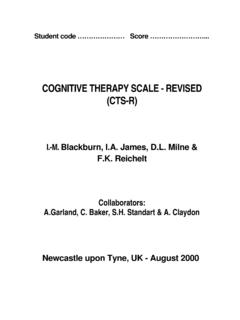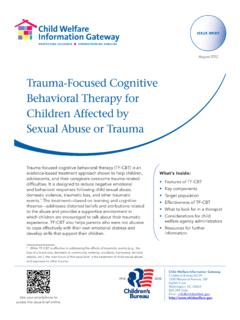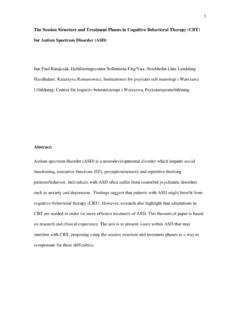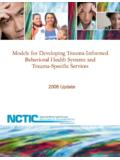Transcription of A Meta-Analytic Review of Adult Cognitive-Behavioral ...
1 ORIGINALARTICLEA Meta-Analytic Review of Adult cognitive -BehavioralTreatment outcome Across the Anxiety DisordersPeter J. Norton, PhD, and Esther C. Price, MAAbstract:The efficacy of cognitive behavioral treatments (CBT) foranxiety in adults has been supported by multiple , most have focused on only 1 diagnosis, thereby disallow-ing diagnostic comparisons. This study examined the efficacy ofCBT across the anxiety disorders. One hundred eight trials of CBTfor an anxiety disorder met study criteria. cognitive therapy andexposure therapy alone, in combination, or combined with relax-ation training, were efficacious across the anxiety disorders, with nodifferential efficacy for any treatment components for any specificdiagnoses.
2 However, when comparing across diagnoses, outcomesfor generalized anxiety disorder and posttraumatic stress disorderwere superior to those for social anxiety disorder, but no otherdifferences emerged. CBT effects were superior to those for no- treatment and expectancy control treatments, although tentativeevidence suggested equal effects of CBT when compared withrelaxation-only Words:Meta-analysis, anxiety disorder, treatment outcome ,CBT.(J Nerv Ment Dis2007;195: 521 531)According to a number of sources (Barlow and Lehman,1996; Chambless and Gillis, 1993; Craske, 1999), en-couraging efficacy data have been obtained across the rangeof Cognitive-Behavioral treatment (CBT) protocols for anxi-ety disorders.
3 Several meta-analyses of anxiety disorder treat-ment outcome studies support these assertions, showingstrong treatment effects of CBT for panic disorder and ago-raphobia (Bakker et al., 1998; Clum et al., 1993; Gould et al.,1995; van Balkom et al., 1997), social anxiety disorder(Fedoroff and Taylor, 2001; Feske and Chambless, 1995;Taylor, 1996), obsessive-compulsive disorder (OCD;Abramowitz, 1997; Kobak et al., 1998; van Balkom et al.,1994), generalized anxiety disorder (GAD; Borkovec andRuscio, 2001; Chambless and Gillis, 1993; Gould et al.,1997), and posttraumatic stress disorder (PTSD; Bradley etal., 2005; Sherman, 1998; Van Etten and Taylor, 1998).
4 (Fora detailed Review of anxiety disorder meta-analyses, seeDeacon and Abramowitz, 2004.)For the treatment of panic disorder with or withoutagoraphobia, Gould et al. (1995), Clum et al. (1993), and vanBalkom et al. (1997) reported that CBT produced significantposttreatment improvement compared with respective controlgroups. treatment effect maintenance data (minimum6-month follow-up) are also supportive, with Gould et al. andBakker et al. describing stable maintenance of treatmenteffects following CBT. Meta-analyses of social anxiety dis-order (Fedoroff and Taylor, 2001; Feske and Chambless,1995; Taylor, 1996) also support the immediate and long-term efficacy of behavioral and CBTs, particularly cognitivetherapy (CT) plus (1997) reported a Meta-Analytic Review ofOCD psychotherapy outcome studies.
5 Results indicated thatexposure with response prevention (E/RP) was significantlymore effective than relaxation (RLX) training; however, nosignificant differences were noted between E/RP and CT, norbetween E/RP and either exposure-only or response preven-tion only. Kobak et al. (1998) and van Balkom et al. (1994)provided strong support for the effectiveness of E/RP forOCD. Borkovec and Ruscio (2001), Chambless and Gillis(1993), and Gould et al. (1997) all provided analyses ofclinical trials for GAD. These studies showed strong post- treatment and follow-up effects for CBT when compared withvarious control conditions. Gould et al. (1997) also reportedthe superiority of CBT over RLX and biofeedback.
6 Gould etal. (1997) also compared psychological and pharmacologicaltreatment effects on GAD and observed a slight advantage ofCBT over pharmacological approaches in the of PTSD treatments have been providedby Van Etten and Taylor (1998), Sherman (1998), and Brad-ley et al., (2005). Van Etten and Taylor suggested thatbehavior therapy and eye movement desensitization and re-processing therapy (EMDR) were equally efficacious treat-ments, with a possible advantage favoring behavior and behavior therapy both showed evidence for main-tenance of treatment gains. Similarly, Bradley et al. (2005)reported substantial improvement for individuals receivingCBT or EMDR, and noted that such improvement was sig-nificantly superior to that observed following waitlist orsupportive control participants.
7 Bradley et al., however, notedno superiority of CBT or EMDR over each other. Finally,Sherman (1998) found similar efficacy support. The majorityof the studies employed a Cognitive-Behavioral or behav-Department of Psychology, University of Houston, Houston, study was supported, in part, by an NIMH Career Development Grant1K01MH073920 (to ).Send reprint requests to Peter J. Norton, PhD, Department of Psychology 126 Heyne Building, University of Houston, Houston, TX 2007 by Lippincott Williams & WilkinsISSN: 0022-3018/07/19506-0521 DOI: Journal of Nervous and Mental Disease Volume 195, Number 6, June 2007521ioral approach, such as flooding, systematic desensitiza-tion, and CT, or EMDR.
8 A significant effect was notedposttreatment, as well as at follow-up, which ranged from3 months to 2 From Anxiety TreatmentMeta-AnalysesMost, albeit not all (Gould et al., 1995; Kobak et al.,1998), of the aforementioned meta-analyses have noted thatcognitive and behavioral treatments show positive therapeuticeffectiveness that is superior, or at least equivalent, to othertreatment modalities. However, the varied inclusion and ex-clusion criteria, methods of estimating effect sizes, and dif-ferent Meta-Analytic strategies used, do not allow for directcomparison of effect size estimatesacrossmeta-analyses. Inpartial response to this, Westen and Morrison (2001) con-ducted a Meta-Analytic Review of the efficacy of empiricallysupported treatments for major depressive disorder (MDD),panic disorder, and GAD.
9 Although concerns have beenraised regarding their methodology and conclusions, such asthe inclusion criteria and the measures from which effectsizes were drawn (Aikins et al., 2001), Westen and Morrisonreported very high pre- to posttreatment average effect sizesfor each diagnostic group. Although the pre- to posttreatmenteffects sizes for MDD and GAD appeared larger than that forpanic disorder, these estimates were not statistically com-pared. Interestingly, despite panic disorder having a lowereffect size, percent responder rates were much higher forpanic disorder than for MDD or GAD. Panic disorder wasassociated with sustained response to treatment whereasMDD and GAD were and Morrison s (2001) work aside, the generallack of comparative outcome analyses between diagnoses hasnot quelled beliefs about the responsiveness of certain disor-ders, particularly GAD and PTSD, to CBT (Brown et al.)
10 ,1994; Norton et al., 2000). Further, questions have beenraised as to whether specific cognitive or behavioral tech-niques may be differentially indicated for specific disorders(Deacon and Abramowitz, 2004). GAD, for example, hadtraditionally been treated using RLX and cognitive tech-niques, while exposure to worry (Borkovec and Costello,1993; Craske et al., 1992) or intolerance of uncertainty(Ladouceur et al., 2000) have been applied more recently totreatment programs. Conversely, treatments for OCD havebeen almost exclusively exposure based, with cognitive mod-els and treatments only recently beginning to receive recog-nition (van Oppen et al.









